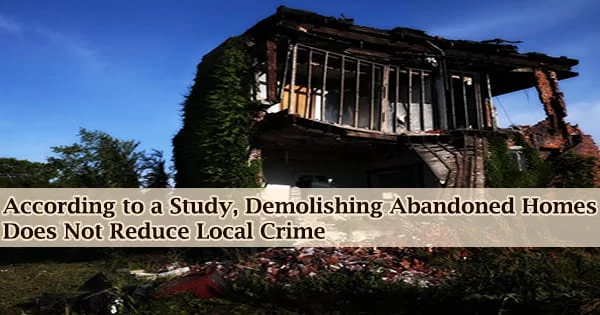Cities all throughout the country have been looking for methods to increase neighborhood safety, and in recent years have suggested that destroying vacant homes is one way to do it.
Although millions of dollars have been spent on the initiatives, a recent research from the University of Kansas concluded that a program in Kansas City, Missouri, to demolish more than 500 abandoned residential properties did not significantly lower local violent or property crime.
Since the 2007–2008 housing foreclosure crisis, there have been an alarming number of abandoned homes around the nation, bringing to light their negative effects on areas, including higher crime rates.
In a study she did, Hye-Sung Han, an assistant professor of public affairs & administration at KU, looked at 559 abandoned homes in Kansas City, Missouri, as well as local crime statistics.
She discovered that localized socioeconomic and housing variables were considerably better predictors of any change in crime rates and that the demolition did not result in a decrease in adjacent crime.
Even though police and city officials claim that demolition increases neighborhood safety and lessens the burden on police by removing places for illegal activities, there hasn’t been much research on whether demolishing abandoned properties reduces crime. This is despite the fact that scholars have long linked abandoned property and crime.
“There is not much data out there on housing abandonment. Because of that, there aren’t many studies done, and those that are, are mostly about how abandonment affects the neighborhood housing market,” Han said.
“But one other negative factor is crime and how it affects the quality of life it has for those still living in neighborhoods with abandoned housing. It has been pretty much proven that there is more crime where there is more abandoned housing.”
Han claimed that she was inspired to research the issue after hearing Kansas City’s former police chief praise a $10 million scheme to tear down 800 run-down, abandoned homes in order to lessen crime in 2016. More than 10,000 abandoned homes exist in the city, but not all of them have been labeled dangerous.
I think one of the reasons demolition doesn’t make a difference is once you demolish the abandoned property, you are left a vacant lot. That is not necessarily better for neighborhood safety. In fact, I found that every single lot where the 559 properties were demolished was still vacant in 2020. Unkept vacant lots can encourage crime.
Hye-Sung Han
Han discovered 559 buildings destroyed between 2012 and 2016. The properties’ neighborhood violence was contrasted with criminality near another abandoned property that wasn’t demolished. In the journal Housing Policy Debate, her study which she co-authored with Scott Helm of the University of Missouri–Kansas City was released.
“I found out the crime around a property that was demolished did not change,” Han said. “So, I looked at other explanations for crime going up or down. I think one of the reasons demolition doesn’t make a difference is once you demolish the abandoned property, you are left a vacant lot. That is not necessarily better for neighborhood safety. In fact, I found that every single lot where the 559 properties were demolished was still vacant in 2020. Unkept vacant lots can encourage crime.”
Han underlined that the study’s goal is to determine whether initiatives that use tax dollars to combat crime are successful rather than to criticize local leaders or the police. The average cost of demolition is between $8,000 and $10,000 per home.
Although the study only looked at Kansas City, comparable programs for demolishing abandoned homes have been implemented in cities across the nation, including Detroit, Philadelphia, Pittsburgh, and Baltimore, some of which demolish thousands of them annually.
Although Han stated she believes comparable outcomes would be expected, one cannot automatically assume that the findings would be the same in other locations as they were in Kansas City. However, there are differences between cities to take into account, such as the types of properties being demolished.
In Kansas City, single-family homes are typically the targets of the wrecking ball, whereas in other cities, row houses with multiple families are more frequently the target and come with a higher price tag.
Han stated that the results indicated that razing abandoned properties does not decrease local crime and that policymakers should take a comprehensive strategy to enhancing neighborhood safety. Specifically in metropolitan areas with high rates of abandoned dwellings, the emphasis should be on enhancing local social and physical qualities.
“In most cases, the very first thing that should happen is to get these houses and properties occupied,” Han said. “So someone is at least living there and paying taxes, and so the city can provide more services.”
















